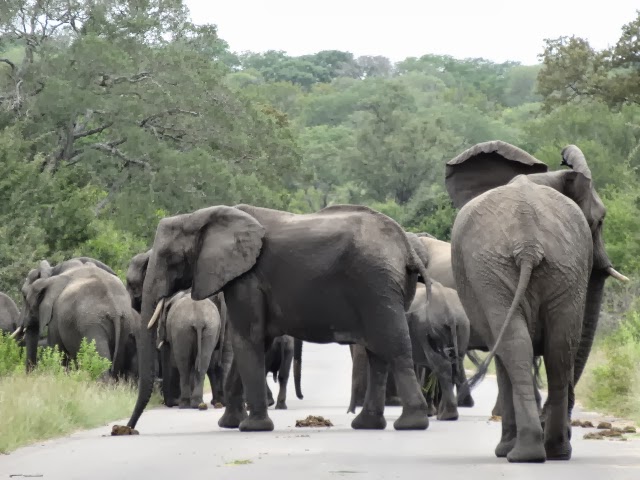 |
| A herd of impalas at the river. |
“Sighting of the Day in the Bush”
 |
| A female kudu in the background isn’t happy that Mr. Kudu is getting all of the attention. |
It’s not so hot today, with the sky primarily overcast with patches of blue peeking through from time to time. By 6:00 am, we were outdoors on the veranda after we’d heard the sound of hoofs on the dry, dusty driveway in front of our vacation home.
 |
| This is a Magpie Shrike. Thanks to friends Lynne and Mick for aiding in identifying today’s birds. |
There stood Mr. Kudu, who’s become a regular in these parts, stopping by a few times each day to see what’s on the agenda. Yesterday, upon returning in the afternoon after our shopping trip to Komatipoort, there were no less than eight kudus in our yard, seemingly awaiting our return.
 |
| This is a Southern Ground Hornbill in the grass. |
Oddly, a group of kudu is called a “forkl” of kudu as opposed to a herd. Here’s a list of plural nouns of African animals from this site:
An armoury of aardvarks
A shrewdness of apes
An army of ants
A troop of baboons
A cete of badgers
A cloud of bats
A herd of buffalo
A coalition of cheetahs
A cartload of chimpanzees
A quiver of cobras
A bask of crocodiles
A murder of crows
A pack of wild dogs
A convocation of eagles
A herd/parade/memory of elephants
A leash of foxes
A flamboyance of flamingos
A tower/journey of giraffes
A band of gorillas
A cast of hawks (general)
A kettle of hawks (in flight)
A boil of hawks (spiraling)
A bloat of hippos
A cackle of hyenas
A leap of leopards
A conspiracy of lemurs
A pride of lions
A troop/barrel of monkeys
A band of mongooses
A parliament of owls
A pandemonium of parrots
A prickle of porcupines
An unkindness of ravens
A crash of rhinos
A venue of vultures
An implausibility of wildebeest
A dazzle of zebras
 |
| This is a Burchell’s Starling. |
I saved this list on my desktop and hopefully will use these nouns to correctly identify groups of animals we post. If any of our readers know of additional plural nouns for other African animals, please post a comment at the bottom of today’s post or send me an email.
 |
| A tower of giraffes at a distance. |
Well, anyway, back to our forkl of kudu…they seemed happy to see us as they freely approached the veranda. Now, don’t get me wrong. We make no assumptions that animals come to visit “because they like us.”
 |
| An implausibility of wildebeest resting under a tree. |
Undoubtedly, the fact we have plenty of pellets along with the opportunity to satisfy their curiosity about humans may be the main reason they come to call. Also, most wild animals have specific paths they regularly follow as they forage for food.
Danie explained that when giraffes graze off the treetops in an area for an extended period, the trees eventually emit a toxic taste, nature’s attempt to send them off to another area to allow the trees to replenish. Isn’t nature amazing?
 |
| Mom and baby zebra. |
It’s these little morsels of information that are of particular interest to us. It’s not always about the wildlife we see and photograph. There’s so much more to this magical place.
 |
| This is an African Fish Eagle. |
Today, we’re staying in, preparing a great dinner, one of our favorites, the “unwich,” lettuce wrapped sandwich (no bread) with fresh ham, chicken, roast beef, tomatoes, purple onion, cooked streaky bacon, mayonnaise, and for me, sliced avocado. On the side, we’ll have a lettuce salad with onions, bits of carrot, celery, and diced tomato tossed with our homemade dressing.
 |
| The one-lane bridge over the Crocodile River. Swimming and boating are not allowed on the Crocodile River due to dangers from crocs and hippos (the animals responsible for more human fatalities than any other in Africa). |
At the moment, it’s quiet with no visitors insight. Indeed, sometime in the next hour or two, we may see a “band of mongooses” running around the yard, looking at us with an expression that says, “You got any of those raw eggs?”
“Yes,” we’ll say, “for you, we do!”
Happy day!
Photo from one year ago today, March 2, 2017:
 |
| One year ago, our cabin on Celebrity Solstice was comfortable and roomier than on some ships at 194 square feet (18 square meters). The balcony is 54 square feet (5 square meters). We have plenty of storage space for our clothing and supplies when able to store our luggage under the bed, leaving ample walking space. For more photos, please click here. |













